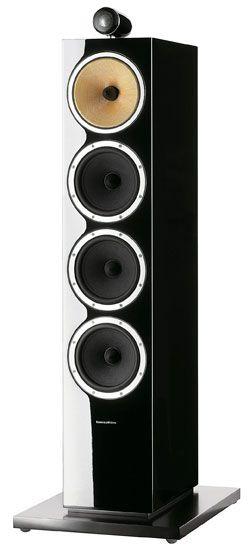B&w Cm10 (£3000)

Like the 804, the CM10 uses a separate [but new] tweeter module. A standard 50µm-thick dome with most of the centre removed forms a stiffening ring and on the front of this is stuck a full dome only 35µm thick. This gives a higher first breakup frequency, said to be 38kHz, yet with a similar moving mass, compared to the standard 50µm dome.
As with the 800 Series models, the tweeter – now protected by a mesh – is decoupled from its housing. A Nautilus tapered tube is screwed to the back of the magnet, and the combination is supported by isolating gel mounts.
Displaying the familar yellow cone of woven Kevlar, the midrange unit is of the ‘surroundless’ or FST type that first appeared in the Nautilus 800 Series. But the CM10 is the first speaker below that series to have a decoupled FST driver. Its gel mountings are compressed by a tensioning rod from the back panel.
With the CM10’s tweeter-on-top format, the midrange compartment could be moved upwards, freeing up more space for the bass enclosure section, which comprises three 165mm paper/Kevlar-coned bass units, reflex-loaded by a rear B&W Flowport.
Stability is assured by using the bolt-on flat plinths extending each speaker’s footprint. Carpet-piercing spikes are provided, along with rubber feet as an alternative.
B&W suggests setting the CM10 at least 0.5m from back and side walls but, moving these speakers further out into the room, we were rewarded with a very open stereo stage, with an even and seemingly undistorted bass.
Clean and open
We found that there were certain benefits to be had from bi-wiring the CM10s. Making the comparison via Myriam Alter’s delightful Where Is There [Enja], we experienced a slightly freer-breathing and more dynamic quality to the bass. We also felt that there was perhaps a little more air around the instruments.
With classical music, we were impressed by the CM10’s ability to produce natural, free-sounding string timbres. It could convey the huge acoustic around the Pacific SO as they played Respighi’s Church Windows [Reference Recordings], but it did well on more intimate material too.
Listening to Rosa Passos and her solo album Rosa [Telarc], we felt that the CM10 really brought out the pure sound of that gorgeous voice along with the rich timbres of her guitar, conveying the calm insulated silence of the studio as well as its supportive acoustic.
With Simple Minds and Cry [Eagle], the sound became truly enveloping as wave after wave of electronic sounds washed over us. The speakers were great on more visceral music too, and with Florence And The Machine’s ‘Dog Days Are Over’ [Lungs, Island/Moshi Moshi], the stunning contrasts and massive drum sounds made it a glorious tour de force.
Verdict
Thanks to its pod-mount tweeter and FST mid driver, the CM10 offers a beautifully clean, detailed midrange and treble, with an open and impressive soundstage. It does, however, need a capable amp to give of its best.
Originally published in the 2013 Yearbook

















































